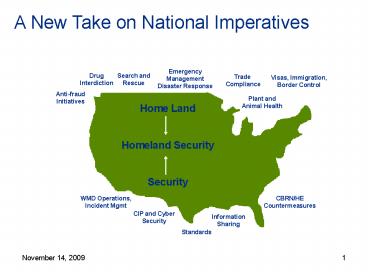S - PowerPoint PPT Presentation
1 / 17
Title: S
1
A New Take on National Imperatives
2
General DHS Organizational Structure
- Coast Guard
- Secret Service
- Citizenship Immigration Ombudsman
- Civil Rights and Civil Liberties
- Legislative Affairs
- General Counsel
- Inspector General
- State Local Coordination
- Private Sector Coordination
- International Affairs
- National Capital Region Coordination
- Counter-narcotics
- Small and Disadvantaged Business
- Privacy Officer
- Chief of Staff
Secretary (Ridge) Deputy Secretary (Loy -
Nominated)
Management (Hale)
Information Analysis Infrastructure
Protection (Libutti)
Border Transportation Security (Hutchinson)
Emergency Preparedness Emergency
Response (Brown)
Science Technology (McQueary)
3
ST is the advocate for CBRN countermeasures
Recover
Respond
Prevent
4
ST Research Agenda
- Homeland Missions
- Bio-Countermeasures
- Chemical Countermeasures
- Radiological and Nuclear Countermeasures
- Standards
- SAFECOM
- Threat and Vulnerability, Testing and Assessment
- Critical Infrastructure Protection
5
ST RDTE Execution
Plans, Programs, and Budgets Defines
Needs Identifies Gaps Prioritizes
Programs Security Missions CBRN/HE
Countermeasures Information Analysis Critical
Infrastructure Protection Interoperability Standar
ds Homeland Missions (USCG, USSS, BTS, EPR)
Operational End Users
Operational End Users
Capability Push/Market Pull
Delivering Capabilities to Operational End-Users
6
Academic community is an important partner
- Adding important cross-cutting research component
to ST through university-based Homeland-Security
Centers - Applying cutting-edge science and technology to
real-world problems through HSARPA projects - Encouraging the development of the first and next
generation of researchers in areas relevant to
homeland security through the DHS Scholars and
Fellows program
7
Federal Stewardship
8
People Homeland Security Scholars Fellows
- 2003 Class
- 50 Scholars and 50 Fellows in engineering, math,
computer science, social sciences, life and
physical sciences - 2004 Class (2/19)
- New competition
- Quality internships
- Alumni network
- Post-doctoral program
9
Building University Programs
- Link university capabilities with HS mission
- Ensure merit based selection process
- Encourage meaningful partnerships
- Build a model for collaboration between Centers
- Engage Undergrad., Grad students and Post Docs
- Link faculty and students to ongoing Natl and
Fedl lab research - Coordination with other agencies
10
Selecting An Academic Center
- Prioritize topics informed by HS legislation
- Inform Universities of needs and goals
- Mission orientation
- Role of Partnerships
- Network of Centers
- Develop merit review procedures External area
expert review internal relevance review
11
Risk Based Economic Modeling
- Developed tools to be available to future Centers
- Subject area addresses a clear and enabling
priority - Exploits university strength in interdisciplinary
research - Emphasizes shared roles of engineering, hard
sciences and the social sciences - Real potential to attract new disciplines and
expertise to homeland security
12
Selection Chronology
- Mid-August Call for White Papers on Risk Based
Economic Modeling 72 received and reviewed by
external and internal reviewers - Early September 12 invited to submit full
proposals by early October and reviewed by
external and internal reviewers - Late October Site visits to 4 institutions
- Early November Recommendation forwarded for
approval - November 25 Public and Federal Register
announcement of USC as first Center of Excellence
13
Homeland Security Center for Risk and Economic
Analysis of Terrorism Events
- Will develop modeling capabilities that cut
across general threats and targets, represented
by application areas such as electrical power,
transportation and telecommunications - Will develop tools for planning responses to
emergencies, to save lives and reduce economic
impacts - Headed by faculty with USCs School of
Engineering and School of Policy, Planning and
Development - Team includes experts from across the country,
and partnerships with universities including New
York University, University of Wisconsin at
Madison, and others
14
Possible Future HS-Centers
- BROAD AGENCY ANNOUNCEMENT
- Agro-terrorism countermeasures addressing
foreign animal diseases and food
contamination(25 proposals received 2/9/04
awards in April) - OTHERS UNDER CONSIDERATION
- Behavioral research on terrorism and
countermeasures - Public perceptions responses to terrorism
- Response technologies and operations
- System deployment information management of
sensor networks
15
Educational Activities
- Three areas Public education post-secondary
responder training. - Significant activity in responder training, but
largely uncoordinated - Public education recognized to be high priority,
but not yet effectively addressed - Colleges universities aggressively establishing
HS courses, programs degrees, with limited
involvement of impacted constituencies
16
Other Likely ST Initiatives
- Joint Programs With Other Agencies (EPC, NSF)
- Security Related Curriculum Development
- Outreach Efforts (e.g. K-12 public education
underrepresented institutions) - Workshops and Conferences
- Research and Education Linkages with
International Community
17
USC Proposal
- Demonstrated linkage with HS mission and
flexibility to adapt to new areas of need - Meaningful partnerships with U of
Wisconsin-Madison, NYU, and others - Prior success in building collaborations between
Centers on and off campus - Clear plans for involving Undergrad, Grad
students and Post Docs, and the use of distance
learning for outreach - Early, meaningful involvement of national labs,
industry and state and local public safety
agencies































